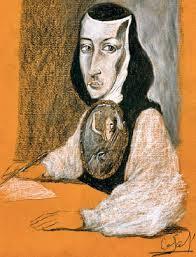

Inundacion castalida (includes verse and the play El neptuno alegorico). 1691 as A Woman of Genius: The Intellectual Biography of Sor Juana Ines de la Cruz, translated by Margaret Sayers Peden, 1982. OtherĮxplicacion sucinta del arco triunfal. N.d.Three Secular Plays of Sor Juana Ines de la Cruz by Guillermo Schmidhuber in collaboration with Olga Marthat Pena Doria, translated by Shelby Thacker. N.d as The House of Trials, translated by David Pasto, 1996.Īmor es mas laberinto. 1690 as Divine Narcissus, translated and annotated by Patricia A.

Plays (individual 17th-century editions)Īuto sacramental de ”El divino Narciso” (produced 1689). Sonnets of Sor Juana Ines de la Cruz in English Verse, translated by Carl W. Poems: A Bilingual Anthology, edited and translated by Margaret Sayers Peden.

Sonetos y endechas, edited by Rosa Chacel. 1951 as Primero sueno, edited by Gerardo Moldenhauer and Juan Carlos Merlo, 1953 as El sueno, translated by John Campion, 1983 as Sor Juana’s Dream, translated by Luis Harss, 1986. 1950.Įl sueno, edited by Alfonso Mendez Plancarte. The Pathless Grove: Sonnets, translated by Pauline Cook. Poesias (selection), edited by Elena Amat. Poesias completas, edited by Emilio Abreu Gomez. Poesias escogidas, edited by Antonio Elias de Molins. Poems, Protest, and a Dream: Selected Writings, translated with notes by Margaret Sayers Peden. 1987.Īnswer: Including a Selection of Poems, translated by Electa Arenal and Amanda Powell. Obra selecta, edited by Lusi Sainz de Medrano. Obras selectas, edited by Georgina Sabat de Rivers and Elias L. Poesia, teatro y prosa (selections), edited by Antonio Castro Leal. Obras completas, edited by Alfonso Mendez Plancarte and Alberto Salceda. Obras escogidas, edited by Manuel Toussaint. 1693, because of the increasing pressure from Church authorities after 1689. 1659, and subsequently wrote verses for official events member of the Carmelite convent in Mexico City, 1667 (for three months) entered Jeronymite Convent of San Paula, Mexico City, 1669, and adopted the religious name Sor Juana Ines de la Cruz abandoned writing, c. Career: Invited to attend the court of the Spanish Viceroy’s wife, the Marquise de Mancera, in Mexico City, c.

Castorena y Ursúa, Juan Ignacio de, 1668-1733.En Madrid : En la Imprenta de Manuel Ruiz de Murga.Generally considered the first edition of 3rd volume of her works (but see Palau, b.Engraved portrait in architectural border ornamented with emblems and armorial bearings of the patrons of this publication, the queen and the marquesa del Valle.Title in red and black initials head and tail pieces.One leaf with "advertencia" tipped in between 4*4 and A1.One leaf with errata and privilege statement tipped in after title page.El doctor Don Juan Ignacio de Castorena y Vrsua. Fama, y obras posthumas del fenix de Mexico, decima musa, poetisa americana, Sor Juana Ines de la Cruz, religiosa professa en el convento de San Geronimo de la imperial ciudad de Mexico : consagralas a la Magestad Catholica de la Reyna Nuestra Señora Doña Mariana de Neoburg Baviera Palatina del Rhin, por mano de la excma.Modern critics recognize her as the most important poet and polemical author working in the Americas during her lifetime. Although her spiritual poems, plays, and essays made her famous among the cultural elite of New Spain, she faced censure in 1690, when her critique of a sermon by a Portuguese Jesuit (and her bold defense of her position) led the bishop of Puebla to prohibit her writings and condemn her intellectual pursuits as unbefitting her gender. As a girl, Sor (Sister) Juana Inés de la Cruz, a nun in Mexico City, taught herself to read several languages, including Latin, Greek, and Nahuatl.


 0 kommentar(er)
0 kommentar(er)
